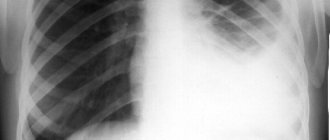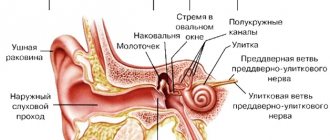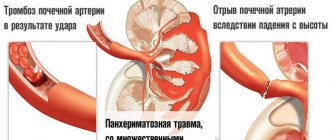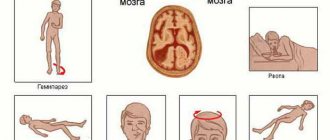Nosebleeds: causes in adults and children
The reasons are divided into local and general. Local processes include processes occurring directly inside the nasal cavity:
- Any injuries to the nose, its mucous membrane and intranasal structures, including injuries caused by surgery or other medical interventions and foreign bodies, head injuries.
- Dystrophic changes in the mucous membrane: curvature of the nasal septum, atrophic rhinitis.
- Neoplasms inside the nasopharynx: granulomas, tumors, angiomas, sarcomas, papillomas, etc.
- Inflammatory processes, due to hyperemia (overflow of blood) of the mucous membrane: sinusitis, rhinitis.
- Dryness of the mucous membrane of the nasopharynx due to insufficient air humidity.
- Inhalation of substances that irritate the nasal mucosa.
Common causes of nosebleeds:
- Cardiovascular pathologies: hypertension, atherosclerosis, heart and vascular defects.
- Significant increase in body temperature due to overheating of the body, sunstroke, infections.
- Hereditary and acquired blood diseases (especially those associated with blood clotting disorders).
- Intoxication of the body (including alcohol).
- Lack or excess of vitamins in the body.
- Overdose of anticoagulants (blood thinning drugs).
- Endocrine pathologies: hypothyroidism (lack of thyroid hormones), hypoestrogenism (deficiency of female sex hormones - estrogens).
- Liver and kidney diseases.
- Physical overexertion.
- Hormonal imbalances or natural hormonal changes in the body (for example, nosebleeds are often observed in pregnant women and adolescents during puberty).
- Changes in the body that arise due to changes in barometric pressure (occur in people engaged in scuba diving or mountaineering, flying by plane or helicopter).
Reference! In 25-50% of cases, bleeding occurs for local reasons, in other cases - for general reasons.
When is a nosebleed a reason to make an appointment with an ENT doctor?
From dry mucous membranes due to insufficient air humidity to cancer, from taking aspirin to liver diseases... Why does nosebleed? Just listing the reasons will take a lot of time.
Start to panic when it occurs or treat it as a minor incident? And finally, what to do if it happens?
With questions about the problem of nosebleeds, we came to an appointment with our permanent expert, otolaryngologist at Clinic Expert Kursk LLC, Alexandra Nikolaevna Emelyanova.
- Alexandra Nikolaevna, how common is the problem of nosebleeds in your patients?
Doctors encounter this pathology quite often. According to public information from domestic and foreign researchers, nosebleeds have occurred at least once in 60% of people’s lives. 6% of them visited doctors, about 1.6 out of 10,000 required inpatient treatment. According to other sources, approximately 5-10% of people have an annual episode of nosebleeds. Less than 10% of them go to the doctor, and only 1% of these 10 require hospitalization.
- Is nosebleeds somehow reflected in ICD-10?
Yes, its code is R04.0
-What are the reasons for nosebleeds? When can nosebleeds occur at night?
Most often, this is not an independent disease, but a manifestation of some other pathology or impact.
What can cause nosebleeds? The causes can be divided into two groups: local and general (systemic).
The first includes trauma to the nasal mucosa (including digital), foreign bodies, operations, infectious diseases of the airways, allergic processes, nasal polyps, low air humidity, neoplasms (in particular, juvenile nasopharyngeal angiofibroma, nasal hemangioma, papilloma, esthesioneuroblastoma ), inhalation of irritating substances (including cocaine).
The second group includes increased blood pressure, disorders of blood coagulation processes (including those associated with liver diseases, chemotherapy and anticoagulant therapy), acquired disorders of platelet function (for example, after using acetylsalicylic acid and other similar drugs), uremia, vascular pathology , hereditary hemorrhagic telangiectasia, pathological changes in collagen, vasculitis, systemic infections (for example, typhoid fever, nasal diphtheria, congenital syphilis, tuberculosis and others).
Thus, nosebleeds can be a sign of serious pathological conditions and therefore require mandatory clarification of the cause that caused it.
There are no specific reasons for nocturnal nosebleeds.
- Are the causes of nosebleeds the same in children, adolescents and adults? Or are they different?
In principle they are the same. However, there are some features, such as juvenile angiofibroma or bleeding, associated with changes in hormonal status during adolescence. In addition, compared to adults, bleeding is more common in childhood due to trauma to the nasal mucosa (for example, digital), infectious pathologies, and leukemia (leukemia).
- Alexandra Nikolaevna, do you need to see a doctor for every nosebleed?
If it is minor, occurred once, and was successfully stopped at home, then there is no reason to immediately consult a doctor to stop the bleeding.
But even here, finding out the cause of bleeding is mandatory, not to mention all other cases (insignificant in volume, but often repeated, or simultaneous heavy bleeding). Why? Because without this it is impossible to be completely sure how dangerous the cause that caused it is. Therefore, in any case, a person cannot do without a trip to the doctor.
- What research methods are used to clarify the cause of nosebleeds?
These are various laboratory and instrumental methods.
Laboratory methods are aimed, in particular, at searching for disorders of the blood coagulation system (studying its plasma and platelet components).
Instrumental include examination of the nasal cavity (rhinoscopy), including using endoscopic technology, magnetic resonance and computed tomography of the nasal cavity and nasopharynx.
Of course, a rational algorithm for diagnostic search and necessary research should be selected by the doctor depending on the specific clinical situation.
- How can you stop nosebleeds at home?
First aid for nosebleeds involves pinching the nose (pressing the wings of the nose against the nasal septum) for 5-20 minutes. If you have nasal vasoconstrictor drops, you can first put a little cotton wool or, preferably, gauze soaked in 3-4 drops of this drug into the nasal cavity, and then pinch your nose.
It must be remembered that vasoconstrictor drops can increase blood pressure (therefore, be sure to check the instructions for specific drops), and therefore may be contraindicated for hypertension. Therefore, if you are bleeding from the nose and have high blood pressure at the same time, these drops should not be used.
-What should you not do if you have a nosebleed?
When your nose is bleeding, you should not throw your head back. This is one of the most common mistakes. Why shouldn't this be done? This can lead to blood entering the esophagus and then the stomach, causing bloody vomiting, or into the respiratory tract, followed by suffocation. For the same reason, you can't lie down.
During bleeding and for some time after, you should not drink hot drinks or food.
It is necessary to exclude the influence of the factor that allegedly caused the nosebleed: for example, go into the shade if it happened in the sun, stop working, especially if it was physical activity.
- How to properly prevent nosebleeds?
It is necessary to ensure proper hygiene at home and in the workplace. First of all, it is cleanliness and normal air humidity. If there are occupational hazards in the form of polluted air, use personal protective equipment. It is mandatory to undergo scheduled medical examinations and preventive examinations. If an episode of bleeding occurs, you should see an ENT doctor to find out the cause of the bleeding and follow his recommendations.
For reference:
Emelyanova Alexandra Nikolaevna
Candidate of Medical Sciences, otolaryngologist at Clinic Expert Kursk LLC.
Graduate of Kursk State Medical University. She completed her primary specialization in residency in the specialty “otorhinolaryngology”. She completed her full-time postgraduate studies at the same educational institution.
Other interviews with Emelyanova A.N.:
How to treat sinusitis at home?
Why can't my ear hear?
Your nose is stuffy, but you don’t have any drops on hand?
Classification of nosebleeds
Bleeding is classified by location and frequency. They may occur:
- In the nasal cavity.
- Outside the nasal cavity (in the nasopharynx, paranasal sinuses, intracranial vessels).
Also, according to localization, the following varieties are distinguished:
- Anterior - the source of bleeding is located above the middle turbinate (a growth on the side wall of the nasal cavity covering the outlet openings of the maxillary and frontal sinuses).
- Posterior – the source is located below the middle turbinate.
Anterior nosebleeds in most cases are not particularly intense and do not pose a threat to health or life. In the absence of blood diseases and vascular pathologies, they usually stop on their own or with minimal first aid measures. In anterior hemorrhage, the patient has blood coming out of the nostril (or both) in drops or a trickle.
Posterior nosebleeds are intense, since large vessels are located in the deep parts of the nasal cavity, and if their integrity is violated, significant blood loss is observed. They can pose a danger to the health and even life of the patient. Posterior bleeding is difficult to stop on your own, so if it occurs, you should immediately seek medical help! In this case, the blood often does not flow out of the nose, but flows down the throat, ending up in the mouth and stomach. Posterior bleeding occurs much less frequently than anterior bleeding.
Reference! The most common source of bleeding is the anterior inferior part of the nasal cavity. This is due to anatomical features. In this area there is a plexus of several layers of arterial and venous networks, which is easily damaged.
Based on frequency, the following types of bleeding are distinguished:
- One-time use.
- Recurrent.
- Familiar.
Reference! Habitual bleeding is one that occurs several times a year.
Symptoms of nosebleeds
The main symptom of nosebleeds is the discharge of blood from the nostrils or its flow into the mouth from the nasopharynx. However, depending on the blood loss, there are also accompanying signs:
- Nausea.
- Spitting blood.
- Pallor of the skin.
- Weakness.
- Noise in ears.
- Thirst.
- Cardiopalmus.
- Flashing of flies before the eyes.
- Dizziness.
Reference! With posterior bleeding, the patient may experience tarry stools, and if blood enters the stomach, vomiting interspersed with blood clots.
Laser coagulation of blood vessels is really effective
See also Treatment of ENT diseases Nosebleeds
Laser coagulation of blood vessels is one of the most gentle and yet effective methods of treating nosebleeds.
Its advantages include:
- The impact is targeted, without causing extensive damage to the mucous membrane and soft tissues.
- Submucosal vessels of any location can be coagulated, if necessary, removing detected telangiectasia and hemangiomas.
- The vessel is vaporized under the influence of the high temperature of a narrowly directed laser beam, instantly and irreversibly switching off from the bloodstream.
- Laser coagulation does not provoke massive thrombus formation and does not lead to the formation of extensive edema.
- The physical discomfort experienced by the patient does not require the use of general anesthesia (anesthesia). Therefore, laser coagulation of blood vessels for frequent nosebleeds can be performed on an outpatient basis, even if the patient has concomitant somatic diseases. There is no long-term disability.
In St. Petersburg, laser coagulation of blood vessels for the treatment of recurrent epistaxis is successfully used in the Clinic of Dr. Korenchenko, supplementing it with other techniques if necessary.
Our doctors recommend not postponing a visit to specialists until difficult to stop nosebleeds develop. Even a single and supposedly causeless episode of bleeding is an alarming sign. And repeated bleeding requires mandatory and prompt consultation with a doctor, even if the amount of blood loss is small. This will allow you to avoid the development of severe complications and carry out the necessary full treatment using the most gentle effective techniques.
First aid for nosebleeds
In case of nosebleeds, the following measures should be taken:
- Place the person on a chair so that his torso leans forward slightly.
- It is best to stop the bleeding with a cotton or gauze swab, moisten it with water or a three percent solution of hydrogen peroxide, place it in the affected nostril and fix it with your fingers.
- Before removal, the tampon is moistened again using a pipette, and then carefully pulled out.
- If there is no tampon at hand, and the bleeding is not caused by an injury to the nasal septum or a broken bone, then the wings of the nose can be gently pressed against the septum using the thumb and forefinger and held for several minutes (no more than 5), while the victim must breathe through the mouth, and tilt your head slightly forward.
- You can place a cold compress or an ice pack on the bridge of your nose for 10–15 minutes.
- When the nosebleed stops, you need to check whether the blood is flowing into the throat: to do this, the victim just needs to spit and see if there is blood in the saliva.
Not allowed:
- Place the person with a nosebleed on their back.
- Tilt the victim's head back.
Attention! If the bleeding does not stop or posterior bleeding is observed, you should urgently visit a doctor or call an ambulance.
Diagnosis of nosebleeds
Diagnostics is carried out in several stages:
- Taking an anamnesis, which in most cases allows you to determine the cause of bleeding (trauma, arterial hypertension, etc.).
- A visual examination of the nose and its cavity, during which the source of the pathology can be determined.
- Blood pressure measurement.
Additional studies may be prescribed:
- General blood analysis.
- Coagulogram (test for blood clotting).
- Tests for mechanical stability of capillaries.
- Study of the hemostasis system.
Differential diagnosis between nasal and gastric or pulmonary bleeding is also important. In this case, the color and consistency of the blood are studied. When it flows from the lower respiratory tract, it is scarlet and foams, and bleeding is accompanied by a cough. With gastric bleeding, the blood is coagulated and dark in color, accompanied by vomiting with brown clots. Exactly the same vomiting is observed with posterior nosebleeds if blood enters the stomach. But in this case, scarlet blood also flows down the back wall of the nasopharynx.
Treatment of nosebleeds
If the bleeding cannot be stopped by pressing the wings of the nose with fingers or tamponade, the following procedures may be necessary:
- Electrocoagulation (“sealing” of blood vessels using electric current).
- Chemical cauterization of blood vessels.
For severe nosebleeds that cannot be eliminated with conservative methods, surgical intervention is performed. The operation is also prescribed if the bleeding is caused by pathologies of the nasal septum - to prevent relapses.
To avoid relapse, it is important to eliminate the cause of the violations. If it is a blood clotting disorder, then hemostatics are prescribed - drugs that increase clotting. If bleeding is caused by vitamin deficiency, the doctor selects vitamin and mineral complexes. If necessary, the patient is referred to a specialist: cardiologist, endocrinologist, urologist, etc.
Prevention measures
Humidify the air in the room using a steam generator; you can also place wet towels on the radiator or spray the room with a spray bottle. Indoor plants also help humidify the air.
Article on the topic
First aid: How to stop heavy bleeding from an open wound?
If crusts often form in your nose, periodically place 2-3 drops of sea buckthorn oil or rosehip oil into your nose.
For frequent bleeding caused by increased fragility of blood vessels, ascorbic acid and rutin are indicated.
Herbal teas from nettle, yarrow, knotweed, plantain, leaves and fruits of sea buckthorn, as well as a 5-10% solution of calcium chloride help increase blood clotting. It is taken 1-2 teaspoons 2-3 times a day after meals. This drug reduces the permeability of the vascular wall.
Bleeding caused by poor blood clotting may be associated with a lack of vitamin K. Its sources include spinach, lettuce, all types of cabbage, avocados, bananas, wheat bran, soybeans, meat, eggs, milk and dairy products, and olive oil.
Preventing nosebleeds
It is certainly not possible to prevent all nosebleeds (especially when it comes to unexpected injuries), but you can minimize the risk of their occurrence. To do this, it is necessary to promptly treat all general pathologies and ENT diseases. If there are several recurring bleedings, you should contact an otolaryngologist. Even if you easily managed to stop the bleeding on your own, you should identify the cause of the pathology, and only a doctor can do this.
Preventive measures also include regular moistening of the nasal mucous membranes and indoor air. You should protect yourself from overheating and try not to inhale irritating substances.
Causes
The vessels in the nasal mucosa are located very densely and close to the surface. The mucous membrane itself is thin and delicate, so it is easily susceptible to injury.
Bleeding may be caused by local damage.
- For example, excessively intensive cleaning of the nose during inflammation of the upper respiratory tract.
- Or when a person blocks a sneeze. The force of the air flow can damage the small blood vessels in the nose.
The risk arises when taking medications that reduce blood clotting - aspirin or heparin, which contribute to hemorrhages and may even cause bleeding themselves. The latter situation is possible if the recommended dosages are exceeded.
Bleeding becomes common for people who use vasoconstrictors for too long to relieve a runny nose. Fortunately, in most cases stopping bleeding is not difficult.









